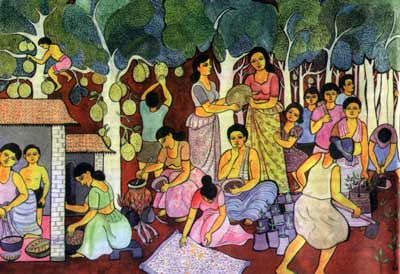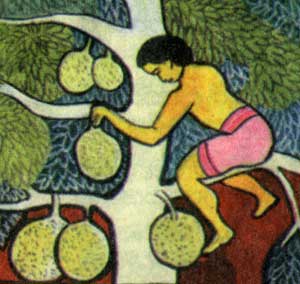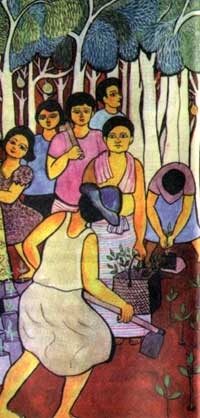Jak as a marker of the life cycle
by Wasantha Wijewardena and Malinda Seneviratne

We are a people who believe in the nae yakku, or wise ancestors long dead. Or, believed to be dead. We believe that they are reborn, sometimes as our own children. It was T.S. Eliot, again, a rare wise man from a civilization gone wrong, who said “the child is father of man”. Let us explain.
One spends an entertaining night transcribing part mechanically part in a dream on a word processor the ancient stories that make up our civilization’s journey. Then one goes home to discover that one’s children are living the most salient of the truths one has been painstakingly putting together as “work”. A man writes down the story about stories related to jak, and goes home to find his woman having crowned their child with a circlet of jak leaves. This is the first and probably the only crown the little girl will wear in her life. It is also the only crown she needs.
 |
 |
The first lessons our children learn is the importance of a mother’s blessing. This is evident in the culture of kos in this country. Our children wore crowns made of jak leaves and mind you, each and every child in the wise world of child’s play could be a king and a queen. They crowned each other without fear, without malice. As well it should be. During the festival of the New Year, they made swings on jak trees. They built playhouses under jak trees and learnt the importance of collective effort.
Gender and other differences were distinctions that got erased as children passed through those thresholds into a more benign and beneficial world. They made human figures out of the jak latex, or koholla. They developed word games like the famous, aththak uda bummagena katu reddak poravagena. Who lies covered in a sheet of thorns, scowling from the branch of a tree? The jak fruit of course!
They collected jak seeds fallen under the tree and played with them. The game, vala kaju geseema, predates all games played with glass marbles by aeons. And, if they felt hungry, they could always roast these “marbles”! If they were still hungry, and there happened to be a ripe jak fruit on a nearby tree, children did not need permission to take it, break it and sample the succulent axils.
The little girl who wore the jak leaf crown, learns about life and at the same time undergoes certain physiological changes. She reaches puberty. She would then return with her mother or an elderly female relative to the jak tree under whose shades she played and learnt. She would obtain the gift of fertility by a few blows on the trunk until the latex oozes, under the direction of her elders. This is the organic way in which they read nature and became connected with those ancient processes.

It should not surprise anyone, given the proximity of jak to all aspect of life that her bodily changes are referred to in terms of the various changes in the life cycle of the jak fruit itself. She is, around the time of puberty, a getissi. The word is derived from two Sinhala words, geta and issi, the protruding of the tender fruit. The reference is of course to the breast. The term of reference naturally follows the trajectory of the development of the fruit, even as she grows more fuller. Thus from getissi she becomes polossi. And, as a term of endearment to one’s beloved, she is someone’s peni varaka madula, the equivalent of “my sweetie”, perhaps.
When the young woman we described above, as appropriate, finds a partner with whom to share the joys and sorrows of life, she is once again united with the jak tree. The ripe jak fruit is considered an aphrodisiac. jak is also said to enhance a woman’s physique, making her fuller and more attractive to the male. It is said that jak is a divine medicine for the skinny woman; “Kettu genunta diva osuvaki herali”. And then it is held that during the jak season, the thighs of women become fuller; “kos kaleta genunge vanna loku venava”.
It is held in the medicinal tracts handed down from generation to generation that jak has immense curative value, especially in lactation. A preparation made of the tender jak fruit, or polos, is often prescribed for pregnant mothers and young mothers. In fact polos is often a delicacy that expectant women desire. Relatives and friends make it a point to bring this as a gift when visiting pregnant women or a woman with a baby. It has also been found that an extract from the leaves is helpful in curing diabetes. kos is used in native medicine to treat other ailments as well. In fact flour made out of the seeds is the main medium in ayurvedic concoctions. The seeds themselves are considered to be particularly effective in treating skin disorders, for the cognitive development of children and in urinary ailments. Mothers all over the country know this. Curried polos is considered to be a palliative for those suffering from piles.
| Living Heritage Trust ©2020 All Rights Reserved |